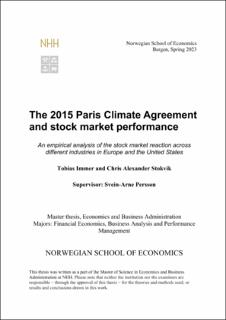The 2015 Paris Climate Agreement and stock market performance : An empirical analysis of the stock market reaction across different industries in Europe and the United States
Master thesis
Permanent lenke
https://hdl.handle.net/11250/3090859Utgivelsesdato
2023Metadata
Vis full innførselSamlinger
- Master Thesis [4372]
Sammendrag
Aggregated market behavior: We used cumulative average abnormal returns (CAARs) to analyze the aggregated market behavior. There were negative average abnormal returns (AARs) in the days leading up to the announcement and positive AARs in the days following the announcement. The U.S. and European markets were both negative leading up to the event, but the U.S. had a stronger reaction with larger CAARs. In the U.S., the two closest windows to the announcement day (-5:-1, -2:-1) were negative and significant, while in Europe, only one window was significant (-5:-1). Both markets turned positive after the announcement of he PA when the terms of the agreement became known. Thus, the announcement day (𝑡�𝑡� =14.12.2015) was a clear shifting point in the market sentiment for the period around the Paris Agreement in both markets. Our interpretation of this shift is that the market viewed the terms of the Paris Agreement as good for business.
Industry market behavior: We used the cumulative abnormal return (CAR) of each industry to analyze the market behavior of each industry. Most industries followed the same pattern as the aggregated market, with a negative CAR before the announcement and a positive CAR after. We expect emissions-heavy industries to have a stronger market reaction. In the windows looking exclusively before the announcement (-15:-1, -7:-1, -5:1, -2:-1), many "brown" industries are among the industries with the biggest negative CARs (Oil, Gas & Consumable Fuels, Construction Materials, Metals & Mining, and Automobiles). The "brown" industries are also among those with the biggest positive CARs in the after windows. This positive CAR in the after period reduces the net effect in the whole period, measured in the equal windows (-15:15, -10:10, -5:5, -2:2) with an equal number of days before and after the announcement. The equal windows have small CARs and low significance levels. Accordingly, it is not possible to say anything conclusive about the market reaction of these industries over the entire period. Beta change: We looked at the beta change of individual industries to measure changes in systematic risk for each industry. We found significant beta changes in eight industries with synchronized behavior in both markets. Two industries, Metals & Mining and IT Services, had an increased beta, which is associated with increased risk. The six industries with reduced beta and reduced risk were: Containers & Packaging, Construction Engineering, Airlines, Communication equipment producers, Electronics equipment producers, and the Entertainment industry.
